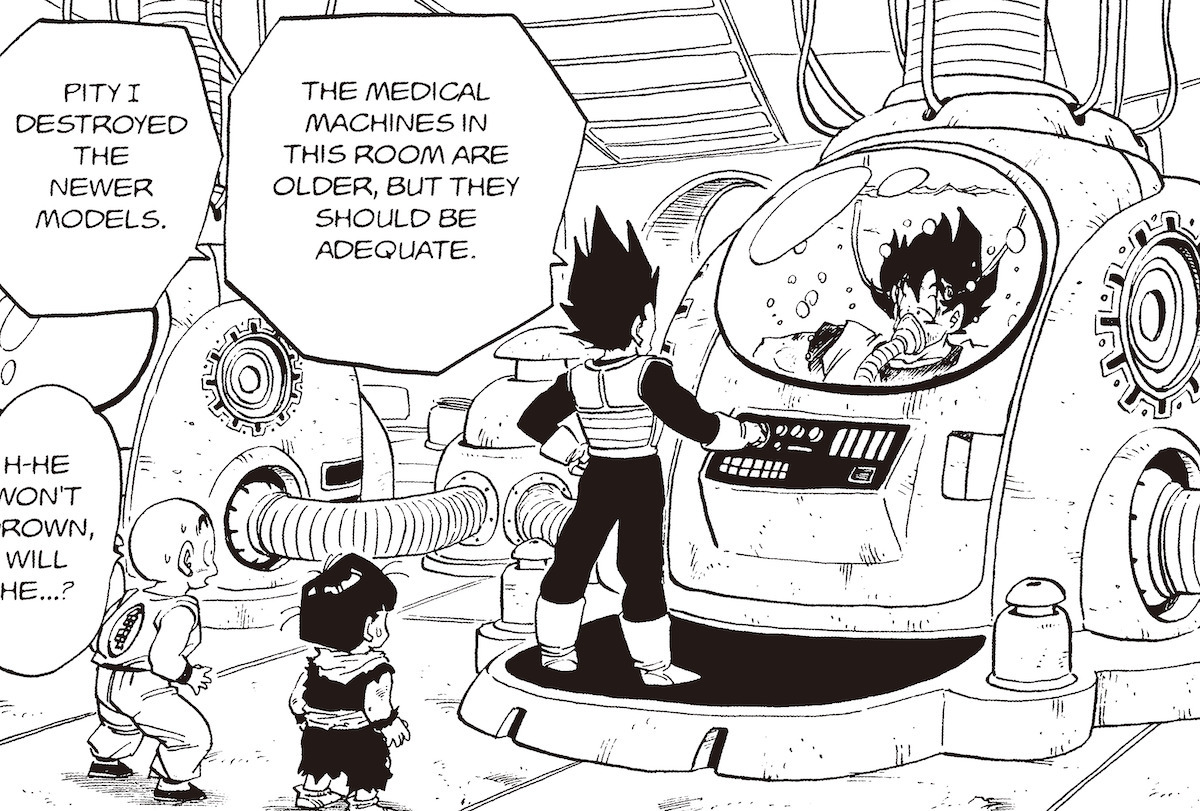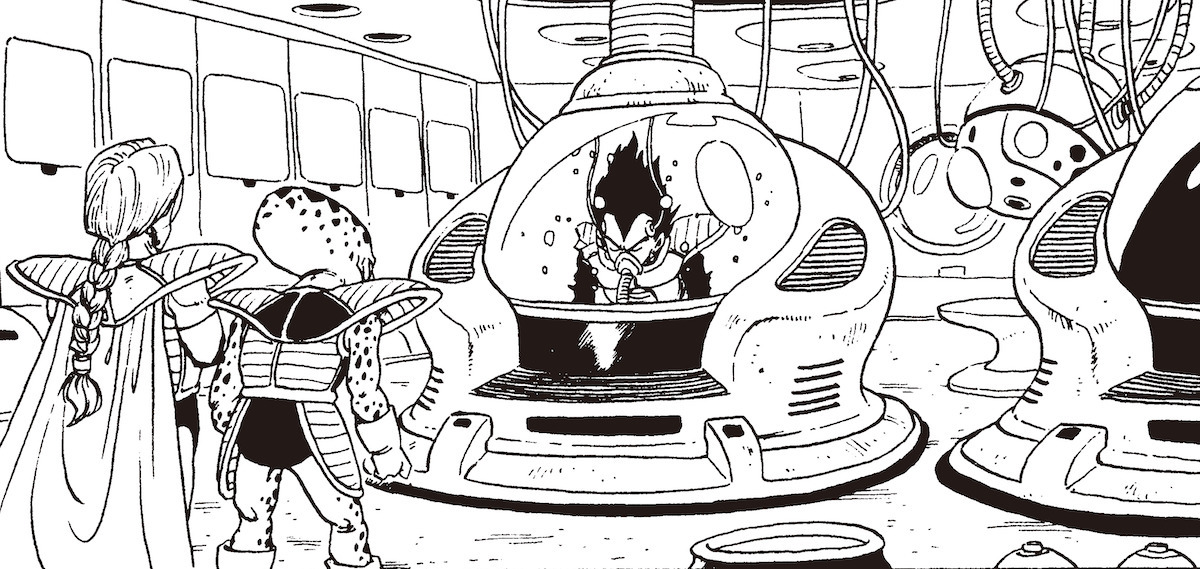NEWS
31.01.2025
What Happens Inside the Medical Machines? We Spoke to a Physician To Find Out

In the world of Dragon Ball, there are several ways to perfectly heal any damage a fighter takes during battle. The Medical Machines used by the Frieza Force are one such example. If a fighter on death's door is placed in one of them, they'll be fully healed within 30 to 40 minutes.
As it turns out, there are machines like this in the real world that can artificially create specialized environments to enhance the healing process. One such method of treatment is referred to as "hyperbaric oxygen therapy" (editor's note: The Ministry of Health, Labor and Welfare, and other such organizations define this treatment as "breathing 100% oxygen at two atmospheres—twice the standard atmospheric pressure, or the pressure at a depth of about ten meters underwater—for more than one hour"). The appearance of these devices and the fact that patients wear masks while inside them remind us of the Medical Machines in Dragon Ball.
Hyperbaric oxygen therapy can be used by athletes trying to speed up their recovery process from injuries. For today's article, we approached Professor Kazuyoshi Yanagishita of the Institute of Science Tokyo, a leading expert on this technology, for his thoughts on how the Medical Machines might work. Will we find out exactly what is going on inside the Medical Machines? And will the capabilities of the Medical Machines be realized in some way in our own future?
.jpg?_=1765709100)
Professor Kazuyoshi Yanagishita: Director of the Hyperbaric Oxygen Sports Medicine Research Group/Professor of the Department of Physical Well-Being at the Institute of Science Tokyo, Liberal Arts Research and Education Center; Head of the Hospital Sports Science Department and Head of the Hyperbaric Therapy Department
Graduated from the Faculty of Medicine at Tokyo Medical and Dental University (now Institute of Science Tokyo). Doctor of Medicine (Tokyo Medical and Dental University). Specializes in orthopedic surgery, hyperbaric oxygen therapy, and sports medicine. He is currently researching and practicing hyperbaric oxygen therapy for radiation damage, sports injuries, and other uses.
―In the world of Dragon Ball there exist Medical Machines that can quickly heal any damage sustained during battle. Your research, Professor Yanagishita, involves hyperbaric oxygen therapy, which is used to treat illness caused by the buildup of harmful gases, and is also used by athletes who want to speed up their recovery from injuries, even just a little. The way people recover inside the machines, how they're used for speeding up recovery from damage or to alleviate certain symptoms; looking at these points, we felt there were similarities between hyperbaric oxygen therapy and Dragon Ball's Medical Machines.
Professor Kazuyoshi Yanagishita (Hereafter, Yanagishita): Hyperbaric oxygen therapy is used all over the world and involves putting someone in a controlled, high-pressure environment and having them inhale high concentrations of oxygen. In cases of acute carbon monoxide poisoning or decompression sickness, a few hours of hyperbaric oxygen treatment can flush carbon monoxide or nitrogen out of the body very quickly and dramatically alleviate symptoms. (Editor's note: decompression sickness is suffered primarily by scuba divers, caused by nitrogen bubbles forming inside the body soon after a dive, which can result in many symptoms, such as joint and muscle pain, dizziness, and disturbance of consciousness.) This speed of treatment seems very similar to the concept of the Medical Machines.
By the way, the hyperbaric oxygen chamber used by the Institute of Science Tokyo Hospital can treat up to 16 people at the same time. The device might look quite similar to the Medical Machines in Dragon Ball as well.
.jpg?_=1765709100)
.jpg?_=1765709100)
On the day of our interview with Professor Yanagishita, he allowed us to take a look inside the hyperbaric oxygen chamber. The machine looks like a submarine.
—Firstly, concerning the capabilities of the Medical Machines, we would like to ask for your expert opinion. Without getting into technical details, is it theoretically possible to treat a patient with severe injuries in a matter of minutes?
Yanagishita: That's a tough question. Scientifically speaking, it takes only a matter of hours to flush gases out of the body with hyperbaric oxygen therapy—for example, carbon monoxide in the case of acute carbon monoxide poisoning, or nitrogen gas in the case of decompression sickness. Once these gases are gone, symptoms caused by them, such as mental impairment or loss of motor function, will likely see improvement remarkably quickly. This type of treatment is actually currently being used in our hospital.
On the other hand, physical injuries cannot be healed with this level of speed. Of course, there is a non-zero possibility that we might see something like the Medical Machine in the future. For example, we may see devices that allow medicine to be delivered to afflicted areas at a speed far faster than what's currently possible.
In the medical world, the term Drug Delivery System (DDS) refers to techniques for quickly delivering drugs to a specific part of the body. There are many ways to deliver drugs into the body; in addition to oral medication, there are also dermal medicines that can deliver drugs through the skin, as well as methods for injecting drugs directly into the bloodstream. If the Medical Machines could be used as one such DDS, it could be quite interesting.
—We weren't sure how the Medical Machines were healing people, but now that you mention "dermal medicine", I think that gives us an idea. When the Medical Machine is activated, the patient becomes immersed in a sort of liquid. Do you think it's possible that this liquid itself includes medicinal properties?

Yanagishita: Perhaps. But I'm more interested in the mask the patients are wearing. This is pure speculation, but it's possible that drugs in a gaseous form are breathed in by the patient, allowing them to be absorbed into the bloodstream through the lungs.

—You're right. We can see there's a sound effect for air bubbles here, so it wouldn't be a stretch to think there's some kind of movement of air into the patient's body.
Yanagishita: To try and bring this theory closer to reality, maybe it's like hyperbaric oxygen therapy, where a large amount of oxygen is taken in and then supplied to the whole body. Using hyperbaric oxygen therapy, ten times the normal amount of oxygen can be supplied to the body, while encouraging nitrogen and other gases to be flushed out. So, if, in the world of Dragon Ball, a character were to be poisoned by some sort of gas attack, and oxygen was being supplied to the character through the mask in order to achieve a speedy recovery, we could say that the Medical Machine is being used in a logical, realistic way.
.jpg?_=1765709100)
Professor Yanagishita takes a look at manga panels while pondering the Medical Machines.
—You mentioned earlier that part of it has to do with flushing out other kinds of gas from the body, but exactly why is the intake of large amounts of oxygen effective for treatment?
Yanagishita: Of course, it all depends on the type of injury or ailment, and also on the type of treatment itself, but let's take sports injuries such as contact injuries or sprains as an example. The injured area will swell up and be painful, right? This swelling actually interferes with peripheral circulation (editor's note: the flow of blood through capillaries), lowering the concentration of oxygen and halting the movement of cells, which ultimately slows down the natural healing process.
However, if hyperbaric oxygen therapy is administered immediately after the injury is sustained, data shows that for a short time, not only will the low oxygen problem be resolved, but normal oxygen levels will be sustained after treatment as well. So, compared to before treatment, swelling and pain levels can be reduced. Of course, it depends on the individual, but there have been cases in which, after undergoing hyperbaric oxygen therapy, an athlete has been able to start competing again 25% faster than usual.
—I didn't realize it made that much of a difference! I imagine any athlete who gets injured before a competitive event will take any chance to recover and get back into good condition more quickly.
Yanagishita: Exactly. For example, in team sports, let's say there's an international competition coming up. For most athletes, if they were to get injured in the first round of the preliminaries, they'd probably try to do everything they could to recover in time for the finals. I've had to manage things so that athletes from Japan could undergo hyperbaric oxygen therapy while abroad, so I've actually seen this firsthand.
—I imagine athletes aren't the only ones thinking, "I need to heal up quick and get back in the fight!" Maybe the members of the Frieza Force had the same thought, and that's what led to the invention of the Medical Machine.
Yanagishita: I guess that just goes to show how they have to be fighting day in and day out. The closest thing I can imagine is the Rugby World Cup. Rugby is a sport that's very heavy on physical contact, so every match results in some kind of contact injury. So, athletes often stop by our clinic immediately after matches to spend some time in the hyperbaric oxygen therapy chambers. In particular, in 2019 the Rugby World Cup was held in Japan, so during that time we had a lot of athletes coming in to be treated.
—By the way, besides athletes, who else can benefit from this treatment?
Yanagishita: Well, for example, if someone becomes diabetic, the peripheral blood vessels can collapse, leading to necrosis of the skin, ulceration on the feet, and other problems. Since these issues are caused by poor circulation, hyperbaric oxygen therapy can be used for treatment in the early stages of skin ulceration.
—That's a wider range of applications than I would have thought.
Yanagishita: Hyperbaric medicine got its start in diving medicine, which consists of research into how to cure decompression sickness. Diving medicine actually has a longer history than you'd expect, and by the 1960s, it was being actively studied around the world. Other types of research branched off from there, including studies into how providing oxygen under high atmospheric pressure could be used as treatment in the early stages of other illnesses. So, thanks to this series of events, these days this therapy can be applied to a wide variety of ailments.
—All right, so we now have an idea of how hyperbaric oxygen therapy works, and we've seen that it kind of looks like the Medical Machine. Now, would you mind showing us how it looks in action?
Yanagishita: So, inside the chamber, the air pressure is increased to two or three atmospheres, and the patient inhales oxygen through a mask, which can then travel to every corner of the body.
.jpg?_=1765709100)
The interior of a hyperbaric oxygen therapy chamber. The patient sits on the chair on the right during oxygen intake.
The concentration of oxygen in the atmosphere is approximately 21%, but during treatment, the concentration inhaled by the patient is 100%, which is about five times that. At three atmospheres of pressure, that's increased threefold, which means that approximately 15 times the usual amount of oxygen is entering the patient's lungs. However, to withstand such a large amount of air pressure, the chamber is made of extremely sturdy metal. Additionally, in order to reduce the risk of fire or explosion, specialized physicians and clinical engineers are onsite monitoring the treatment.
.jpg?_=1765709100)
—Now I have a better understanding of all the ways hyperbaric oxygen therapy can come in handy. Even if we don't reach the level of the Medical Machine, do you think that with continued research, even more applications will be found for this therapy?
Yanagishita: Of course, something like the Medical Machine where you can just hop in the chamber and be healed from anything and everything would be ideal, but unfortunately, that's just not possible with hyperbaric oxygen therapy. There's not much we can do but continue our efforts to seek out other illnesses that could benefit from this treatment.
...However, perhaps someday there will be another researcher somewhere who takes the concept of this therapy and applies it in a serious effort to invent an actual Medical Machine. There are countless examples of things depicted in science fiction becoming a reality due to advancements in technology, so it's within the realm of possibility. In the future, maybe the technology to quickly heal all kinds of injuries will be developed, and its inspiration will have come from Dragon Ball. Everything starts from a single thought, after all.
.jpg?_=1765709100)
Interviewer/Writer: Noriyuki Enami (Yajirobe)
Photography: Kayo Sekiguchi
This site includes machine-translated texts. Please be aware that you might find some unusual expressions that are difficult to understand.
Post
Confirm Post
Post the above comment?
Reply
Confirm Reply
Post the above comment?
Are you sure you want to delete this comment?
Report successful
Post Unsuccessful
This user will be muted.
You will be unable to see comments from muted users in the comments area.
*To unmute users, navigate to the "Comments" area on MY PAGE.
Reply
Confirm Reply
Post the above comment?
Edit
Post


Post
Confirm Post
Post the above comment?
Edit
Post